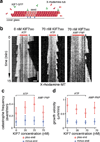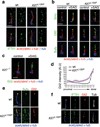The kinesin-4 protein Kif7 regulates mammalian Hedgehog signalling by organizing the cilium tip compartment
- PMID: 24952464
- PMCID: PMC4085576
- DOI: 10.1038/ncb2988
The kinesin-4 protein Kif7 regulates mammalian Hedgehog signalling by organizing the cilium tip compartment
Abstract
Mammalian Hedgehog (Hh) signal transduction requires a primary cilium, a microtubule-based organelle, and the Gli-Sufu complexes that mediate Hh signalling, which are enriched at cilia tips. Kif7, a kinesin-4 family protein, is a conserved regulator of the Hh signalling pathway and a human ciliopathy protein. Here we show that Kif7 localizes to the cilium tip, the site of microtubule plus ends, where it limits cilium length and controls cilium structure. Purified recombinant Kif7 binds the plus ends of growing microtubules in vitro, where it reduces the rate of microtubule growth and increases the frequency of microtubule catastrophe. Kif7 is not required for normal intraflagellar transport or for trafficking of Hh pathway proteins into cilia. Instead, a central function of Kif7 in the mammalian Hh pathway is to control cilium architecture and to create a single cilium tip compartment, where Gli-Sufu activity can be correctly regulated.
Figures








Comment in
-
Kif7 keeps cilia tips in shape.Nat Cell Biol. 2014 Jul;16(7):623-5. doi: 10.1038/ncb2997. Nat Cell Biol. 2014. PMID: 24981634
-
Organelle dynamics. KIF7 organizes cilia.Nat Rev Mol Cell Biol. 2014 Aug;15(8):498-9. doi: 10.1038/nrm3839. Epub 2014 Jul 9. Nat Rev Mol Cell Biol. 2014. PMID: 25005343
-
Location, location, and location: compartmentalization of Hedgehog signaling at primary cilia.EMBO J. 2014 Sep 1;33(17):1852-4. doi: 10.15252/embj.201489294. Epub 2014 Jul 17. EMBO J. 2014. PMID: 25037564 Free PMC article.
Similar articles
-
Hedgehog-induced ciliary trafficking of kinesin-4 motor KIF7 requires intraflagellar transport but not KIF7's microtubule binding.Mol Biol Cell. 2022 Jan 1;33(1):br1. doi: 10.1091/mbc.E21-04-0215. Epub 2021 Oct 27. Mol Biol Cell. 2022. PMID: 34705483 Free PMC article.
-
Mouse Kif7/Costal2 is a cilia-associated protein that regulates Sonic hedgehog signaling.Proc Natl Acad Sci U S A. 2009 Aug 11;106(32):13377-82. doi: 10.1073/pnas.0906944106. Epub 2009 Jul 29. Proc Natl Acad Sci U S A. 2009. PMID: 19666503 Free PMC article.
-
Collaborative role of two distinct cilium-specific cytoskeletal systems in driving Hedgehog-responsive transcription factor trafficking.Sci Adv. 2025 Mar 14;11(11):eadt5439. doi: 10.1126/sciadv.adt5439. Epub 2025 Mar 12. Sci Adv. 2025. PMID: 40073114 Free PMC article.
-
Microtubule Motors Drive Hedgehog Signaling in Primary Cilia.Trends Cell Biol. 2017 Feb;27(2):110-125. doi: 10.1016/j.tcb.2016.09.010. Epub 2016 Oct 17. Trends Cell Biol. 2017. PMID: 27765513 Free PMC article. Review.
-
Cilia and developmental signaling.Annu Rev Cell Dev Biol. 2007;23:345-73. doi: 10.1146/annurev.cellbio.23.090506.123249. Annu Rev Cell Dev Biol. 2007. PMID: 17506691 Free PMC article. Review.
Cited by
-
Spinocerebellar ataxia type 11-associated alleles of Ttbk2 dominantly interfere with ciliogenesis and cilium stability.PLoS Genet. 2018 Dec 10;14(12):e1007844. doi: 10.1371/journal.pgen.1007844. eCollection 2018 Dec. PLoS Genet. 2018. PMID: 30532139 Free PMC article.
-
Cellular signalling by primary cilia in development, organ function and disease.Nat Rev Nephrol. 2019 Apr;15(4):199-219. doi: 10.1038/s41581-019-0116-9. Nat Rev Nephrol. 2019. PMID: 30733609 Free PMC article. Review.
-
Dysfunction of the ciliary ARMC9/TOGARAM1 protein module causes Joubert syndrome.J Clin Invest. 2020 Aug 3;130(8):4423-4439. doi: 10.1172/JCI131656. J Clin Invest. 2020. PMID: 32453716 Free PMC article.
-
The kinesin motor protein Kif7 is required for T-cell development and normal MHC expression on thymic epithelial cells (TEC) in the thymus.Oncotarget. 2017 Apr 11;8(15):24163-24176. doi: 10.18632/oncotarget.15241. Oncotarget. 2017. PMID: 28445929 Free PMC article.
-
The novel ciliogenesis regulator DYRK2 governs Hedgehog signaling during mouse embryogenesis.Elife. 2020 Aug 6;9:e57381. doi: 10.7554/eLife.57381. Elife. 2020. PMID: 32758357 Free PMC article.
References
Publication types
MeSH terms
Substances
Grants and funding
LinkOut - more resources
Full Text Sources
Other Literature Sources
Medical
Molecular Biology Databases
Miscellaneous

